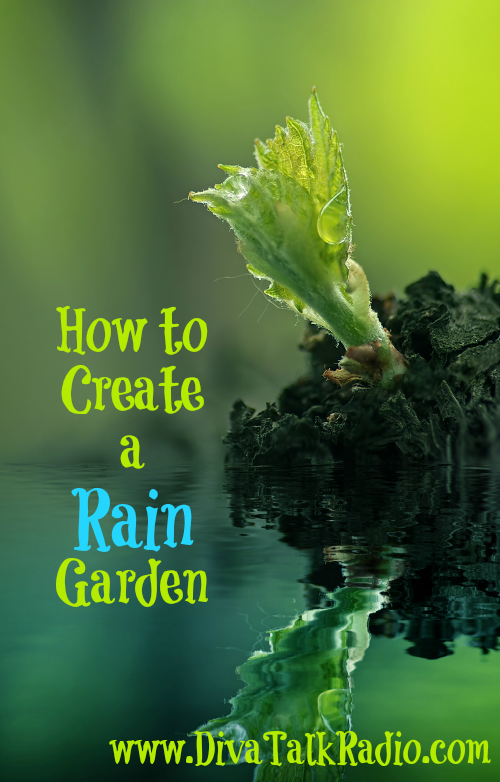 You may have heard rain gardens referred to as “sunken gardens.” This is because they are planted in a depression in the ground, which acts like a bowl for holding rain water.
You may have heard rain gardens referred to as “sunken gardens.” This is because they are planted in a depression in the ground, which acts like a bowl for holding rain water.
Rain gardens capture storm run-off from non-porous surfaces like roofs and driveways, directing it to a garden where it will nourish plants rather than ending up in the local sewer or drainage system. Pollutants from streets and rooftops can get into the waterways, creating a pollution problem that rain gardens can, in a small way, help solve.
Have you been wanting to start one, but are unsure of where to begin? Here are some simple, basic steps to help you get started on creating a rain garden.
Choose a Location
Location is everything when it comes to rain gardens. There are some basic do’s and don’ts to consider first.
- Don’t place your rain garden right next to a building. The extra moisture is not good for the foundation. Sources suggest placing it at least ten feet away.
- Level ground is considered better than sloped; level areas hold the water better.
- If you have a septic system, do not put a rain garden over it.
- Sunken gardens near trees can damage the tree’s roots with excess water. So go for an open area away from trees.
- Determine how large it should be in relation to the impermeable areas that will be draining into it. A good rule of thumb is, bigger is better. It’s hard to go wrong with a rain garden that’s very large, but you can go wrong with one that’s too small to accommodate the run-off. You can increase the size by going deeper, too, to make up for a lack of yard space.
- Make sure you have adequate drainage. In areas with heavy clay soils, this is especially important. You may think that choosing a spot that has a natural pond or pool after a rainfall is a good choice, but it’s important to find out why that ponding happens. Observe the area after a rain and see how long it takes the water to drain away. If it takes more than twelve hours, it may not be a good place. If it’s drained within twelve hours, you may have a great spot for your rain garden. If the spot isn’t just right drainage-wise, there are some things you can do to prepare the soil.
Prepare the Location
Dig out the area to the desired depth. This is hard work, so be forewarned that it may take a while and you may want some friends to help. Save the soil if your rain garden is on a slope; you’ll want the extra dirt to build an earthen dam or wall along the lower edge of the garden.
Once it’s dug, be careful that you don’t walk in the bottom of it too much and compact the soil. Make it roughly level by removing and adding soil where necessary. Work in compost if you need to improve drainage.
Add Plants
Nearly all sources agree that native plants work best. They usually need the least coddling and will put down strong roots, and they support the native eco-systems. Diversity is healthy, so plant an assortment. Finally, the plants should, of course, be water lovers that thrive in a wet environment. Remember, water-loving shrubs and small trees are fine additions that tend to soak up lots of water.
Creating a rain garden is fairly easy and a great way to save water that would otherwise drain away!
That’s it for now. Until next time Divas, wear your heels well and Be Blessed!
P.S. Let’s connect! Follow us on social media by clicking on the icons under THE DIVA DIGEST NEWSLETTER opt-in box. (Top right.) Thanks so much!




 Some of the links on this site are affiliate links. If you click on those links and make a purchase, Kelli Claypool will receive a small commission. This is greatly appreciated as all affiliate income is donated back into our community as part of our Mission 500 Project. Affiliate links contained within a post are noted accordingly.
Some of the links on this site are affiliate links. If you click on those links and make a purchase, Kelli Claypool will receive a small commission. This is greatly appreciated as all affiliate income is donated back into our community as part of our Mission 500 Project. Affiliate links contained within a post are noted accordingly. Please note that Kelli Claypool is not, nor are any of our guest bloggers, Interns, or contributing writers (unless otherwise noted within their bio) certified nutritionists, herbalists, counselors or doctors. Information shared on this website is from our own individual research and/or opinion and is for informational and entertainment purposes only. Please conduct your own diligent research as we cannot be held accountable for any undesirable outcome.
Please note that Kelli Claypool is not, nor are any of our guest bloggers, Interns, or contributing writers (unless otherwise noted within their bio) certified nutritionists, herbalists, counselors or doctors. Information shared on this website is from our own individual research and/or opinion and is for informational and entertainment purposes only. Please conduct your own diligent research as we cannot be held accountable for any undesirable outcome. Thank YOU for being here! Without our readers and loyal listeners, this website would be a very quiet place. Thank YOU for taking the time to read our posts, listen to our shows, and give us your encouraging feedback. Our goal is to support you, to love you, and to inspire you to live victoriously in all areas of your life.
Thank YOU for being here! Without our readers and loyal listeners, this website would be a very quiet place. Thank YOU for taking the time to read our posts, listen to our shows, and give us your encouraging feedback. Our goal is to support you, to love you, and to inspire you to live victoriously in all areas of your life.
Leave a Reply